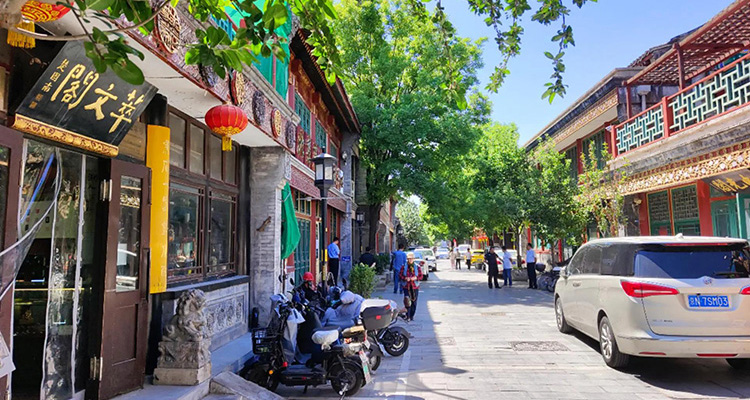Liulichang, Beijing: 800-Year Cultural Treasure Walk
1. Strolling Through History: The Story Behind Liulichang
Walking along Liulichang, Beijing, feels like opening a living encyclopedia of Chinese culture. Every step is a conversation with history. The streets are lined with grey stone slabs, ancient-style shops, and traditional eaves adorned with black-and-gold signs. There’s no high-rise pressure, no modern mall chaos—only a peaceful historical atmosphere as if time itself slows down here.
The air carries a faint scent of ink and old books, mixed with the occasional aroma of tea. Along the street, century-old shops like Rongbaozhai, China Bookstore, and Yidege quietly tell stories of 800 years of history.
The name “Liulichang” has roots in the 13th century, when the Yuan Dynasty established imperial kilns here to produce glazed tiles for the palace. During the Ming and Qing Dynasties, it gradually transformed into a cultural street, filled with bookstores and stationery shops for scholars and officials. Today, it stretches about 800 meters in Beijing’s Xicheng District, spanning East and West Liulichang Streets, showcasing traditional Chinese culture.

2. Historic Walks: Scholars, Books, and Cultural Feasts
Walking through Liulichang, you may tread the footsteps of countless historical figures. During the Qing Dynasty, officials compiling the Siku Quanshu often visited local bookshops here, turning the street into a “public library” for scholars.
In the Republic of China era, Lu Xun was a frequent visitor. Over his 14 years in Beijing, he visited Liulichang hundreds of times, collecting thousands of stone rubbings and ancient texts.
Liulichang also marked a turning point for artist Qi Baishi in 1921. Initially unnoticed, his works displayed at Rongbaozhai gained recognition and eventually fame in Japan. Even after becoming a master, Qi entrusted most of his paintings and carvings to Rongbaozhai for sale.
Though the Cultural Revolution brought hardships, Liulichang survived and was restored in 1980, regaining its status as a cultural hub.

3. Immersive Experiences: Calligraphy, Shopping, and Taste of Beijing
Cultural Shopping
Rongbaozhai, established in 1672, is a top destination for calligraphy, brushes, ink, and art. Its woodblock printing techniques are so precise that even Qi Baishi struggled to distinguish originals from reproductions.
China Bookstore is a paradise for old book enthusiasts, featuring rare collections, historical texts, and classical Chinese literature.
Daiyuexuan offers exquisite traditional brushes, crafted meticulously for decades, and Yidege provides high-quality ink. Many shops host live demonstrations, allowing visitors to watch artists at work throughout the year.

Food Experience
Liulichang also delights food lovers. Xinyuanzhai’s sour plum juice is a refreshing local drink, while Douzhi Zhang’s fermented mung bean drink with fried dough rings offers authentic old Beijing flavors.
Special Events
During the Spring Festival, the Changdian Temple Fair, dating back to the Ming Dynasty, is the liveliest time in Liulichang. Visitors can explore cultural exhibitions, local crafts, traditional snacks, immersive shows, and interactive experiences like writing “Fu” characters or stamping keepsakes.

4. Travel Guide: Planning Your Liulichang Visit
Location & Transport
Liulichang is located along Nanxinhuajie Street, Xicheng District, near Qianmen and Dashilan commercial streets.
- Subway: Line 2 (Hepingmen Station, Exit C1/D), walk 600m south. Line 4 (Caishikou Station), 10 min walk.
- Bus: Lines 7, 14, 15, 66, 70. Stop at Liulichang.
- Driving: Not recommended; parking is limited.
Best Visiting Time
Open year-round; most shops operate 9:00–17:00. For traditional atmosphere, visit during the Spring Festival temple fair. For quiet browsing, mornings on weekdays are ideal.
Suggested Duration
2–3 hours recommended, longer if you are a Chinese culture enthusiast. Nearby attractions include Yangmeizhu Xiejie, Dashilan, and Beijing Fang.

5. Cultural Tips: Smart Exploration
- Payments: Cash and mobile payments widely accepted.
- Bargaining: Common in antiques and art shops but less so for fixed-price items.
- Etiquette: Do not touch delicate artworks without permission; avoid cutting across transaction areas.
- Language: Basic Mandarin phrases enhance your experience:
- “Zhè gè duōshǎo qián?” — How much is this?
- “Kěyǐ piányí yīdiǎn ma?” — Can it be cheaper?
- “Xièxiè” — Thank you
As the sun sets, Liulichang glows golden, lanterns light up, and visitors leave with their treasures, while shopkeepers prepare for the next day. This living museum of culture continues to enchant visitors, telling its 800-year story of tradition and art.


